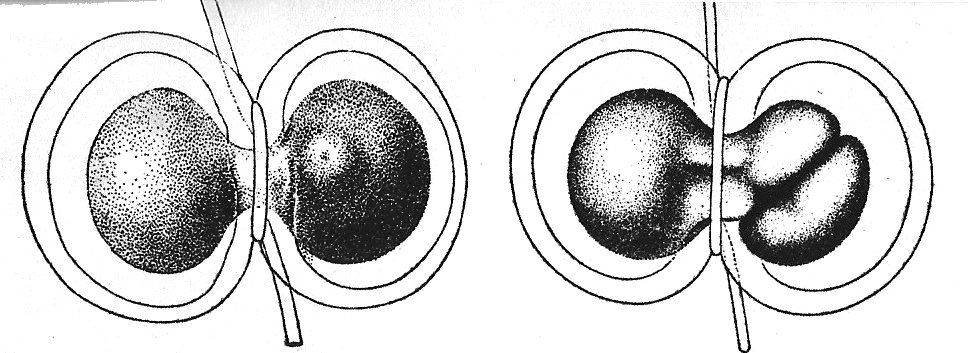
Spemann Experiment with the Grey Crescent (1902)
Hans
Spemann repeated the Roux / Driesch
experiments, using salamander eggs. Instead of killing
one cell or separating 2- or 4-cell embryos, Spemann devised a
micro-surgical technique that used extremely fine
baby's hair (from the head of his own newborn son!) to
separate the single-cell egg into two halves. The hair was
tied in a slip knot, passed around the egg as a ligature, and
gradually tightened without breaking the egg membrane
Spemann observed that the two halves often developed into two complete embryos, consistent with the previous results of Driesch. However, he also observed that this depended critically on the plane of cleavage. If the division bisected a well-known morphological feature of the egg cortex, the Grey Crescent, both halves developed normally. If the Crescent were confined to only one side of the cell, that half would develop normally, but the other half would develop only as a shapeless mass of undifferentiated cells. Spemann reasoned that the Grey Crescent was a morphogenetic field that determined the fate of subsequent cells.
Subsequently, it was determined that the Grey Crescent is formed by the 30o rotation of the fertilized egg to form a dorsal / ventral axis. The crescent thus serves as a determinant of dorsal / ventral polarity: cells without it have no means of orientation, and fail to develop normally.
Similar experiments done with Xenopus frogs in the FEB ("Frog Experiment Bay") on the Space Shuttle confirmed this, where experiments in micro-gravity also disrupted dorsal / ventral orientation.
Spemann observed that the two halves often developed into two complete embryos, consistent with the previous results of Driesch. However, he also observed that this depended critically on the plane of cleavage. If the division bisected a well-known morphological feature of the egg cortex, the Grey Crescent, both halves developed normally. If the Crescent were confined to only one side of the cell, that half would develop normally, but the other half would develop only as a shapeless mass of undifferentiated cells. Spemann reasoned that the Grey Crescent was a morphogenetic field that determined the fate of subsequent cells.
Subsequently, it was determined that the Grey Crescent is formed by the 30o rotation of the fertilized egg to form a dorsal / ventral axis. The crescent thus serves as a determinant of dorsal / ventral polarity: cells without it have no means of orientation, and fail to develop normally.
Similar experiments done with Xenopus frogs in the FEB ("Frog Experiment Bay") on the Space Shuttle confirmed this, where experiments in micro-gravity also disrupted dorsal / ventral orientation.
Text material © 2022 by Steven M. Carr